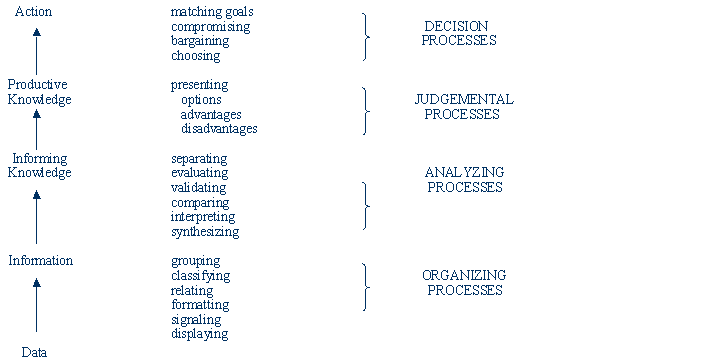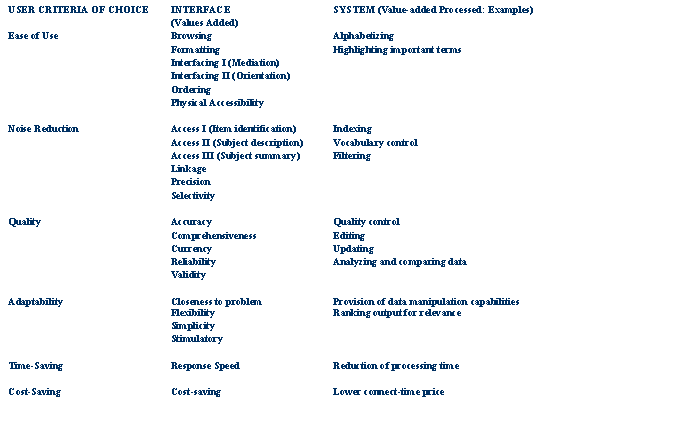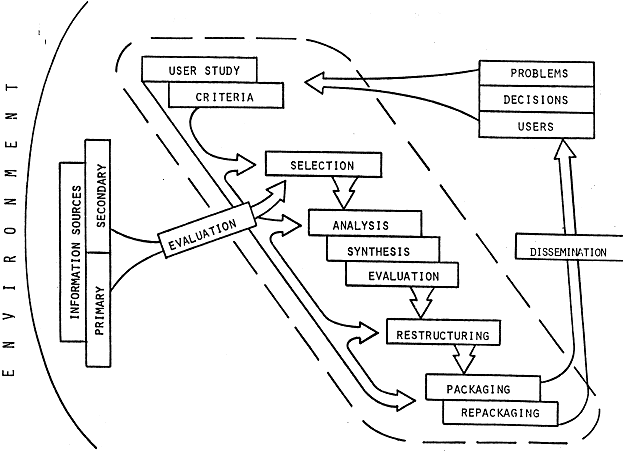
Slide 1
INFO 414 Information Behavior
Information Consolidation
User Centered Design
The Value-added Model
Slide 2
User centered design (Allen, 1996)
Identify a user population
Investigate the information needs of the user group
Discover the tasks that users accomplish as they meet these information needs
Investigate the resources that users require to complete these tasks
Summarize the preceding steps in user models
Consider each design decision in the light of resource augmentation and enabling
Slide 3
Identify a user population
The first step in user-centered design is to find a user population.
Sometimes user identification is dictated by the mission of the organization where the designer works. In other cases, users may be selected by the designer.
The identification of the user population is such an obvious step that it is sometimes omitted. This omission results in systems that are not particularly usable for any set of users.
Slide 4
Investigate the information needs of the user group
Information needs can be investigated using a wide range of research methods.
The key element of this step is to talk to users and find out what kinds of information they need to resolve the problems they encounter.
No information system can meet all of the information needs of a user group.
Once the full range of information needs has been identified, system designers must select those that their information system will be designed to meet.
Slide 5
Discover the tasks that users accomplish as they meet these information needs
Talk to users and observe them as they work on meeting their information needs.
Identify the tasks that users employ as they meet their information needs and how they accomplish these tasks.
Try to distinguish between the tasks that are essential and those that are optional.
The result will be one or more task models for each information need.
Slide 6
Investigate the resources that users require to complete these tasks
Each task completed by a user who is meeting an information need requires a variety of resources: background knowledge, procedural knowledge, and abilities.
List the resources required for each task and identify the level of the resources required.
It is important to note the levels of these resources that users possess.
Slide 7
Summarize the preceding steps in user models
For each distinct user group to be served by the information system, there will be a number of information needs that the system is designed to meet.
For each of these information needs, there will be a number of tasks that must be accomplished.
For each of the tasks, there will be a list of resources that are necessary.
Integrating these elements together results in a user model that can be used to guide design decisions or that can be implemented as part of the information system to direct how the system will respond to users.
Slide 8
Summarize the preceding steps in user models
User Group
Information Needs
Tasks
Resource
Slide 9
Consider each design decision in the light of resource augmentation and enabling
The goal of system design is to allow users to complete the tasks that will meet their information needs. With this in mind, system features that will augment the resources of users when necessary will enable them to complete the tasks.
Some of these features will be required by all users, while others will be required by only a portion of the user group. Experimental research can be used to select system features that should be implemented as user-selectable options.
Slide 10
The value added model
An information system is a series of value-adding processes, the result of which help the users or clients to make choices or clarify problems
Information systems are a series of formal processes by which the potential usefulness of specific input messages being processed is enhanced.
Slide 11
Value-Added Spectrum (Taylor, 1986)

Slide 12
User Criteria and
Values Added
Taylor (1986)

Slide 13
Value-Added Processes (Taylor, 1986)
Access (Noise Reduction): the values added by the intellectual technologies that provide the systematic meanings, based on subject matter, of narrowing the information universe to a set of data and information which have some probability of containing material that is wanted or needed. Different kinds of intellectual access provide different sets of the subject universe.
Access I (Noise Reduction): the value achieved by the identification of any information chunk or discrete piece of data by systematic physical description and location information.
Access II (Noise Reduction): the provision of a subject description through access points such as index terms, descriptors, and names.
Access III (Noise Reduction): the result of processes which reduce or compress large amounts of information into compact items, such as executive summaries, abstracts, terse conclusions, chemical structure diagrams, mathematical formulae, graphs, or charts.
Slide 14
Value-Added Processes (Taylor, 1986)
Accuracy (Quality): the value added by system processes that assured error-free transfer of data and information as it flows through the system and is eventually displayed to a client.
Browsing (Ease of Use): the capability of a system to allow a client to scan an information neighborhood, with the probability that the client will serendipitously find information of value.
Closeness to Problem (Adaptability): the value added by the activities of the system, usually through human intervention, to meet the specific needs of a person in a particular environment with a particular problem; this implies knowledge of that personís style, bias, idiosyncrasies, and sophistication, as well as the politics and constraints of the context.
Comprehensiveness (Quality): value added by the completeness of coverage of a particular subject or of a particular form of information.
Cost savings: the value achieved by conscious system design and operating decisions what save dollars for the client.
Slide 15
Value-Added Processes (Taylor, 1986)
Currency (Quality): the value added (a) by the recency of the data acquired by the system; and (b) by the capability of the system to reflect current modes of thinking in its structure, organization, and access vocabularies.
Flexibility (Adaptability): the capability of a system to provide a variety of ways and approached of working dynamically with the data/information in a file.
Formatting (Ease of Use): the physical presentation and arrangement of data/information in ways that allow more efficient scanning and hence extraction of items of interest from the store.
Interfacing (Ease of Use): the capability of the system to interpret itself to users.
Interfacing (Mediation) (Ease of Use): the means used to assist users in getting answers from the system.
Interfacing (Orienting) (Ease of Use): the means used to help users understand and to gain experience with the system and its complexities.
Slide 16
Value-Added Processes (Taylor, 1986)
Linkage (Noise Reduction): the value added by providing pointers and links to items, sources, and systems external to the system in use, thus expanding the clientís information options.
Ordering (Ease of Use): the value added by initially dividing or organizing a body of subject matter by some form of gross ordering, such as alphabetization, or large groupings.
Physical Accessibility (Ease of Use): the processes of making access to information stores easier in a physical sense.
Precision (Noise Reduction): the capability of a system to aid users in finding exactly what they want, by providing signals on such attributes as language, data aggregation, sophistication level, or by ranking output.
Reliability (Quality): the value added by the trust a system inspired in its clients by its consistency of quality performance over time.
Slide 17
Value-Added Processes (Taylor, 1986)
Selectivity (Noise Reduction): the value added when choices are made at the input point of the system, choices based on the appropriateness and merit of information chunks to the client population served.
Simplicity (Adaptability): the value achieved by presenting the most clear and lucid (explanation, data, hypothesis, or method) among several within quality and validity limits; not to be confused with simplistic.
Stimulatory (Adaptability): those activities of an information system that may not be directly supportive of its primary mission, but which assume importance in establishing a presence in the community or organization served and which encourage use of the system and/or its staff expertise.
Time savings: the perceived value of a system based on the speed of its response time.
Validity (Quality): the value added when the system provides signals about the degree to which data or information presented to users can be judged as sound.
Slide 18
Consolidated information is...
public knowledge available through the published record; documented for a particular group of users
specifically selected and analyzed
possibly restructured and repackaged
where the criteria for selection, evaluation, repackaging, restructuring are all derived from the potential user group
Slide 19
Information consolidation
The process of evaluating and modifying information from relevant sources in order to provide defined user groups with new information products and services that meet their information needs
Slide 20
Information consolidation
Set in the marketing and user oriented framework...
identifying user needs
identifying gaps in the provision of products and services to meet those needs
closing gaps by developing appropriate products or services
Slide 21
The purposes of information consolidation...
to meet the information needs of a target group based on
a knowledge of their needs
a knowledge of the criteria that the target group use to evaluate information
to overcome problems of
information overload; inappropriate levels of information; inappropriate context of information; inappropriate form; untrustworthy information
Slide 22
Information consolidation involves...
Study of potential users
Selection of information source(s) that potentially contain the most useful information for given user needs
Evaluation of information in terms of its intrinsic merit, validity and reliability
Slide 23
Information consolidation involves...
Restructuring (if necessary) of extracted information into a content that can be used most effectively and efficiently by users
Packaging and/or repackaging of restructured information in a form that will enhance the potential of its use
Slide 24
Information consolidation involves...
Diffusion or dissemination of information in ways that will encourage its use
Feedback from users, evaluation of the information consolidation product and then making adjustments
Slide 25
Key assumptions ...
the ultimate purpose of the IC process and the IC product is that it will be used to satisfy an information need or resolve an information problem
purposeful use; value has been added - ultimately this value is assigned by the user who recognizes its usefulness in a given context
things are known about potential users
information behavior; information needs
information professionals must evaluate
Slide 26
The IC process incorporates all the roles of an information professional?
Common functions of an information professional include ...
identification of information need
information search design
retrieval of information
evaluation of information
synthesis of information
packaging of information
Slide 27
The IC process incorporates all the roles of an information professional?
repackaging of existing information products
dissemination of information
design and provision of information services
Not so common functions ...
evaluating the worth of information from a subject perspective
restructuring and repackaging information from a subject perspective
Slide 28
Processes in Information Consolidation
